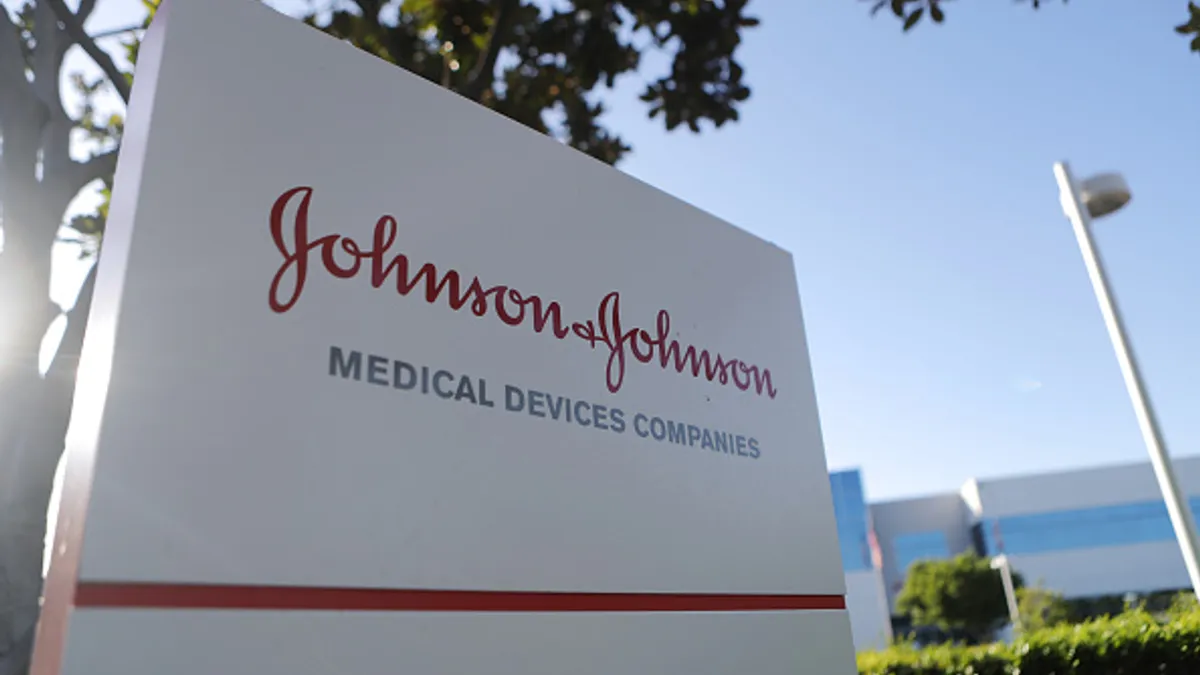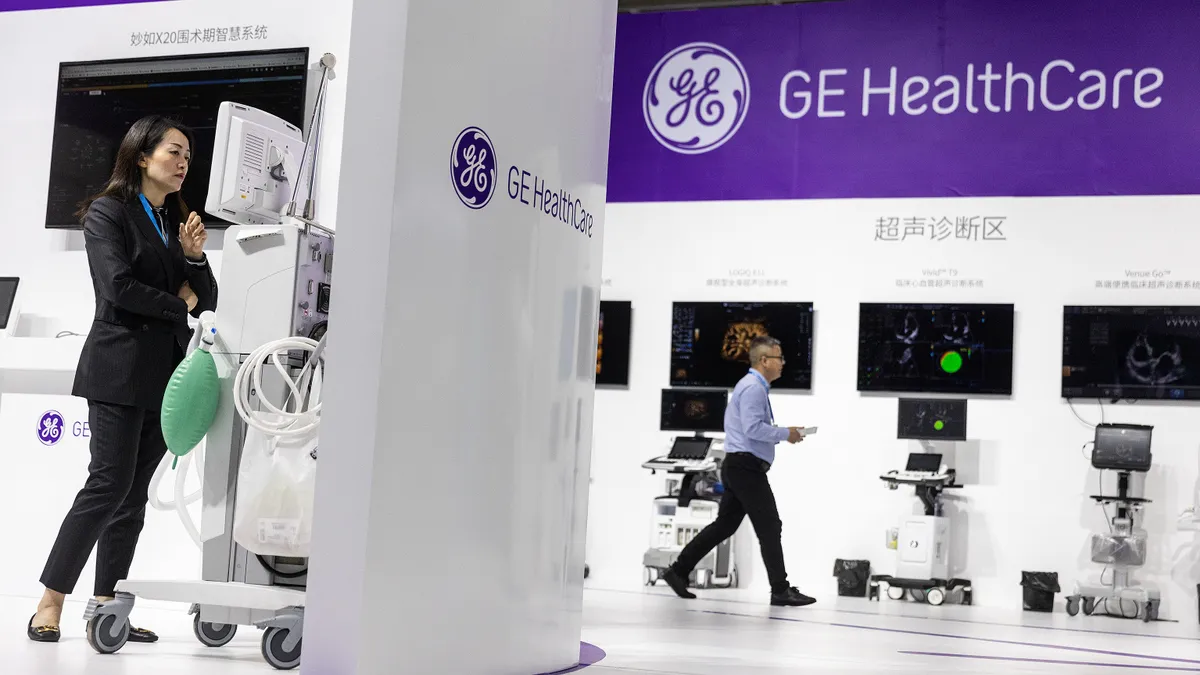In his first earnings call as CEO of Johnson & Johnson, Joaquin Duato set a course for an "aggressive" M&A strategy, especially when it comes to medical devices.
Duato, who became CEO on Jan. 3, is looking for products in higher-growth markets where J&J can take a leading position. Duato said during a January earnings call that the company would emphasize smaller, tuck-in deals, though would also consider medium-size deals "if the situation is granted."
J&J's changing approach to dealmaking comes as the company is splitting off its consumer health unit to focus more on its pharmaceutical and medical device businesses. Now, as the company stresses a more aggressive M&A strategy, could another big deal be on the horizon for the healthcare giant?
M&A environment
One of Johnson & Johnson's biggest medtech acquisitions, its $19.7 billion purchase of orthopaedics manufacturer Synthes, closed about a decade ago. Since then, it has made a handful of big deals including its $4.3 billion bid for Abbott Medical Optics, which greatly expanded J&J's ophthalmology business, and its $3.5 billion acquisition of surgical robotics company Auris Health.
However, the company has primarily made smaller, tuck-in buys since 2010, according to M&A data from BTIG.
A closer look at J&J's medical device segments
| Segment | 2021 Revenue | Subsidiaries |
|---|---|---|
| Interventional solutions | $3.97B | Biosense Webster, Cerenovus |
| Orthopaedics | $8.59B | DePuy Synthes |
| Surgery | $9.81B | Ethicon |
| Vision | $4.69B | Johnson & Johnson Vision (formerly Abbott Medical Optics) |
SOURCE: J&J full year 2021 earnings
Taking a more aggressive approach is in line with M&A strategies from other large medtechs such as Abbott Laboratories and Medtronic.
Abbott CEO Robert Ford told investors in January that the COVID-19 testing business has helped the company build stronger cash flow over the last 18 months, putting it in a "great position" to spend.
"Tuck-in and medium-sized deals probably are more likely ... again, if those situations present themselves," Ford said. "But again, we're always looking at everything."
Medtronic has also emphasized tuck-in deals for the last year. In a Tuesday earnings call, CEO Geoff Martha said the company's "pipeline is fuller than it has been over the last two years." In particular, Medtronic is looking for billion- to multibillion-dollar deals, such as its recent acquisition of Intersect ENT.
Smaller, tuck-in deals are generally safer bets as they're easier to integrate and companies can build portfolios or fill gaps through multiple deals in a year. Last year's medtech spending spree saw companies like Boston Scientific and Hologic each making five separate acquisitions.
"Large scale medtech M&A … the jury's still out on whether that really creates value for shareholders," said John Babbit, life sciences partner at Ernst & Young. "What clearly works — and you can see this whether it's at Medtronic or Boston Scientific or Stryker: Tuck-in acquisitions where they can really leverage their infrastructure have played very, very well into the growth equation."
Still, large companies, flush with cash, likely will be "aggressive on the M&A front" in 2022 after a record-breaking 2021, Babbit added.
Notable J&J acquisitions in the last 12 years
*Source: BTIG, J&J
-
July 2010
Micrus Endovascular, $480 million
-
September 2010
Crucell, $2.3 billion
-
2012
Synthes, $19.7 billion
-
2017
Abbott Medical Optics, $4.33 billion
-
2019
Auris Health, $3.45 billion
-
2021
OrthoSpin, $79.5 million
-
2022
CrossRoads Extremity Systems, undisclosed
Other pressures also may make mergers more palatable for growing medical device companies. Continuing labor shortages in hospitals may lead to consolidation in the space, potentially limiting the number of facilities medtechs can sell to and making bundled products more attractive, said BTIG analyst Ryan Zimmerman.
Increasingly volatile public markets also may make companies more likely to consider M&A.
Of course, the price also has to be right, as emphasized by J&J and other companies in their earnings comments. While valuations have softened, high-growth medtechs are currently trading at high multiples.
"We've seen some valuation adjustments more recently, but still there's a pretty big disconnect," Babbit said.
Mega deals vs. Tuck-ins
Because J&J traditionally has been made up of three businesses — pharmaceutical, medical devices and consumer health — the healthcare giant has access to resources that other medtechs typically do not.
For example, J&J said in January that it had $32 billion in cash and marketable securities by the end of 2021, compared to Medtronic's $2.9 billion in cash and cash equivalents, which the medtech reported in December.
Even as J&J plans to shed its consumer health companies, money for medical device M&A has the potential to still outpace competitors.
The question is, what gaps does J&J need to fill?
Danielle Antalffy, an SVB Leerink analyst, said that cardio is a clear gap for the company and one that could be filled with a major pickup: Boston Scientific.
"I mean, it would be a huge deal for J&J. They could do it, and they get market-leading position across cardio and actually into some of these other areas, like urology, for example," Antalffy said. "A Boston Scientific acquisition in my mind for J&J makes so much sense. It would be a huge deal but makes a ton of sense."
Antalffy added that cardio is a "big need for hospitals" and J&J does not have a lot of cardiac products to offer.
Edwards Lifesciences could be another cardiac target with its leading transcatheter aortic valve replacement business and other growing segments. However, Edwards has a more narrow corner on the market and does not provide the scale that Boston Scientific can offer.
"Boston Scientific makes a ton more sense than an Edwards because you're still not getting the same level of scale … I feel like healthcare is moving in that direction," Antalffy said. The analyst added that Medtronic showed a sign of favoring scale with its roughly $43 billion purchase of Covidien in 2014 to be a "one-stop-shop" for hospitals.
BTIG's Zimmerman pushed back a bit on the idea of J&J doing a larger deal.
"I don't believe that investors always want massive conglomerates in MedTech," Zimmerman said in an emailed statement. "Acquiring for size and scale isn't necessarily rewarded."
Duato told investors in January that there is no "artificial ceiling as far as deal size," but the new CEO stressed that larger deals are difficult to pull off financially and operationally.
Although Synthes is now a big part of J&J's orthopaedics business, called DePuy Synthes, J&J faced some challenges integrating the company early on. J&J had hundreds of millions of dollars in integration costs, and a year after the deal closed it was less than halfway done combining the two businesses.
Zimmerman said that J&J could be looking for tuck-in companies in stroke or ophthalmology. Antalffy agreed that ophthalmology may be an area for M&A, calling out Glaukos, which specializes in treating glaucoma, corneal and retinal conditions. But Antalffy added that, again, the company would not provide J&J with "the scale that I think is going to be something that they will increasingly want over the next five years."
During last month's earnings call, J&J said it's looking to hold a number one or two spot in its medtech markets. While the company is making gains in robotics surgery markets, it is still behind soft-tissue leader Intuitive Surgical and orthopaedic leaders Stryker and Zimmer Biomet.
J&J could look to make a move to boost its robotics portfolio as procedure adoption and system placements are growing, maybe looking to companies with robotic spine offerings like Globus Medical and NuVasive. Still, Antalffy and Zimmerman said that the company has already invested billions in robotics and a deal would be surprising.
If J&J, or larger companies like Abbott and Medtronic, decided to make large pickups, Antalffy said it could create a domino effect where bigger medtechs try and keep up with each other.




















